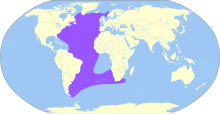| Great shearwater | |
|---|---|

| |
| Ten miles off Sagres, Portugal | |
| Conservation status | |
 Least Concern (IUCN 3.1) | |
| Scientific classification | |
| Domain: | Eukaryota |
| Kingdom: | Animalia |
| Phylum: | Chordata |
| Class: | Aves |
| Order: | Procellariiformes |
| Family: | Procellariidae |
| Genus: | Ardenna |
| Species: | A. gravis |
| Binomial name | |
| Ardenna gravis (O'Reilly, 1818) | |

| |
| Synonyms | |
| |
The great shearwater (Ardenna gravis) is a large shearwater in the seabird family Procellariidae. It breeds colonially on rocky islands in the south Atlantic. Outside the breeding season it ranges widely in the Atlantic.
Taxonomy
The great shearwater was formally described in 1818 by the Irish naturalist Bernard O'Reilly and given the binomial name Procellaria gravis. The great shearwater is now placed in the genus Ardenna that was introduced in 1853 by Ludwig Reichenbach. The genus name Ardenna was used to refer to a seabird by Italian naturalist Ulisse Aldrovandi in 1603. The specific epithet gravis is Latin meaning "heavy" or "weighty". The species is monotypic: no subspecies are recognised.
Description
This shearwater is 43–51 cm (16.9–20.1 in) in length with a 105–122 cm (3.5–4.0 ft) wingspan. It is identifiable by its size, dark upper parts, and white under parts, with the exception of a brown belly patch and dark shoulder markings. It has a black cap, black bill, and a white "horseshoe" on the base of the tail. The stiff flight, like a large Manx shearwater, is also distinctive. The only other large shearwaters in its range are the Cory's Shearwater and the all-dark Sooty Shearwater.

Distribution and habitat
The great shearwater, like the sooty shearwater, follows a circular migration route, moving north up the eastern seaboard of first South and then North America, before crossing the Atlantic in August. It can be quite common off the southwestern coasts of Great Britain and Ireland before heading back south again, this time down the eastern littoral of the Atlantic.
Behaviour and ecology
This bird has the typically "shearing" flight of the genus, dipping from side to side on stiff wings with few wingbeats, the wingtips almost touching the water. Its flight is powerful and direct, with wings held stiff and straight.
Breeding
This species breeds on Nightingale Island, Inaccessible Island, Tristan da Cunha, and Gough Island. It is one of only a few bird species to migrate from breeding grounds in the Southern Hemisphere to the Northern Hemisphere, the normal pattern being the other way around. This shearwater nests in large colonies, laying one white egg in a small burrow or in the open grass. These nests are visited only at night to avoid predation by large gulls.

Food and feeding
The great shearwater feeds on fish and squid, which it catches from the surface or by plunge-diving. It occasionally feeds on crustaceans, fish entrails and other refuse discarded by fishing vessels. It readily follows fishing boats, where it indulges in noisy squabbles. This is a gregarious species, which can be seen in large numbers from ships or appropriate headlands. They have a piercing "eeyah" cry usually given when resting in groups on the water.
Great shearwaters are among the seabird species with the highest incidence of plastic ingestion.
References
- BirdLife International (2018). "Ardenna gravis". IUCN Red List of Threatened Species. 2018: e.T22698201A132633747. doi:10.2305/IUCN.UK.2018-2.RLTS.T22698201A132633747.en. Retrieved 13 November 2021.
- O'Reilly, Bernard (1818). Greenland, the adjacent seas, and the North-west Passage to the Pacific Ocean, illustrated in a voyage to Davis's strait, during the summer of 1817. London: Craddock and Joy. p. 140, Plate 12 fig. 1.
- O'Connor, J. P. (1985). "Bernard O'Reilly: Genius or Rogue?". The Irish Naturalists' Journal. 21 (9): 379–384. JSTOR 25538895.
- Reichenbach, H. G. Ludwig (1853). Avium systema naturale. Dresden and Leipzig: Expedition der vollständigsten naturgeschichte. p. IV. The title page has 1850 (original title page missing in the BHL scan but available from BSB). The Preface is dated 1852 but the volume was not published until 1853.
- ^ Gill, Frank; Donsker, David; Rasmussen, Pamela, eds. (January 2022). "Petrels, albatrosses". IOC World Bird List Version 12.1. International Ornithologists' Union. Retrieved 19 February 2022.
- Jobling, James A (2010). The Helm Dictionary of Scientific Bird Names. London: Christopher Helm. pp. 54, 178. ISBN 978-1-4081-2501-4.
- Yamashita; et al. (2021). "Plastic additives and legacy persistent organic pollutants in the preen gland oil of seabirds sampled across the globe" (PDF). Environmental Monitoring and Contaminants Research. 1: 97–112. doi:10.5985/emcr.20210009. S2CID 241803983.
- "Puffinus gravis (Great shearwater)". Animal Diversity Web.
- Peter G. Ryan (1987). "The incidence and characteristics of plastic particles ingested by seabirds". Marine Environmental Research. 23 (3): 175–206. Bibcode:1987MarER..23..175R. doi:10.1016/0141-1136(87)90028-6.
Further reading
- Austin, Jeremy J.; Bretagnolle, Vincent & Pasquet, Eric (2004): A global molecular phylogeny of the small Puffinus shearwaters and implications for systematics of the Little-Audubon's Shearwater complex. Auk 121(3): 847–864. DOI: 10.1642/0004-8038(2004)1212.0.CO;2 HTML abstract
- Bull, John L.; Farrand, John Jr.; Rayfield, Susan & National Audubon Society (1977): The Audubon Society field guide to North American birds, Eastern Region. Alfred A. Knopf, New York. ISBN 0-394-41405-5
- Harrison, Peter (1987): Seabirds of the world : a photographic guide. Princeton University Press, Princeton. ISBN 0-691-01551-1
External links
| Taxon identifiers | |
|---|---|
| Ardenna gravis |
|
| Procellaria gravis | |

